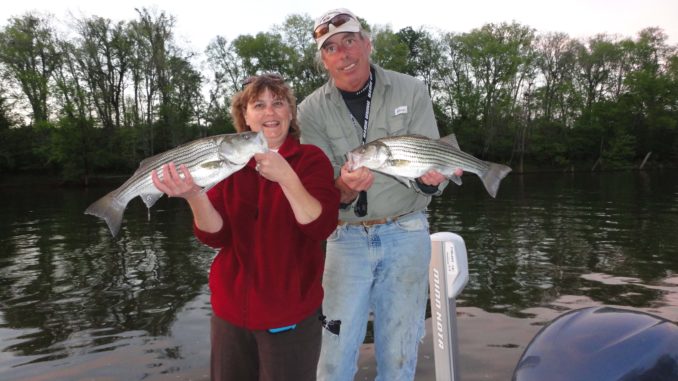
May 1 marks end of “keeper season” on river
For 325 days, there’s nothing special about the Roanoke River. At least that’s the opinion of Rod Thomas of Capt. Ponytail Guide Service. It’s those 30 days from April 10 to May 20 that make it, according to Thomas, “the crown jewel of river fishing in North Carolina.”
“There is nowhere you can catch more fish per square inch than on that river,” Thomas said.
The fish are striped bass, and the spring spawning run, which is just hitting full stride this week, is an awesome thing to see. Literally millions of stripers move out of the ocean and the Albemarle Sound, into the Roanoke, and move upstream the 90 or so miles to the outskirts of the town of Weldon. Their migration is stopped there, first by a series of rapids, then a mile or so farther upstream, by Roanoke Rapids Dam.
Thomas says the N.C. Wildlife Resources Commission estimates that three million fish make the annual move up the river. The biggest females come from the places far away in the ocean.
“The three biggest fish that were tagged in the river last year were caught within 30 days off Cape Cod and New Jersey,” Thomas said. “They spend 11 months of the year in the ocean and one month up in the river making babies. It’s just another river the rest of the year, but for six weeks, it’s a fish heaven.”
May 1 marks the beginning of Thomas’ favorite part of the run. April 30 is the end of the “keeper” season when anglers can keep two fish a day, with certain size restrictions. From today through March 31, 2014, it’s a catch-and-release only fishery, with only single-hook, artificial lures allowed.
May 1 also marks a big drop in the number of boats and fishermen on the river, and it gives Thomas and the dozen or so guides who make up to 50 or 60 half-day trips a chance to take a deep breath and enjoy the remainder of the run.
“The fishing is just great after May 1,” he said.
It may be even better this year, because the spawn appears to be at least two weeks late because of a cool March that kept fish in the lower stretches of the river.
Thomas said fish will bite just about anything, except when they’re in the actual act of spawning, where dozens of males rush one spawning female and slam into her, apparently in an effort to dislodge her egg so they can fertilize them.
The rest of the time, you can catch fish on a swimbait, a jerkbait, a bucktail, any kind of soft-plastic trailer on leadhead jig, any kind of streamer fly, not to mention topwater plugs. On topwater plugs or jerkbaits – lures that generally carry multiple treble hooks – Thomas pulls off the trebles and puts a single “J” hook on the middle ring, with the barb smashed flat.
You’ll catch fish as long as you fish close to the bank.
“Eighty percent of the fish coming up the river stay within 20 yards of either bank,” Thomas said. “You catch more fish on the bottom, but they’ll feed up. Most fish are caught in six to 10 feet of water. You want your bait to be two or three feet deep. The more violent you make your retrieve, the better; you’ll have your best chance of catching a fish.
“When you get in a school of fish and they’re biting, you get in front of them and drift through them again and again,” he said. “This is a great place to start the year; when you leave, your chest is all poked out.”


Be the first to comment